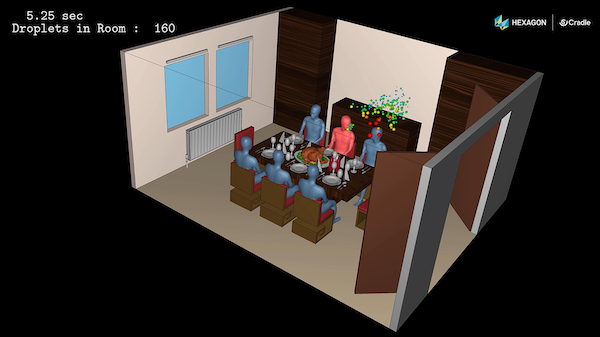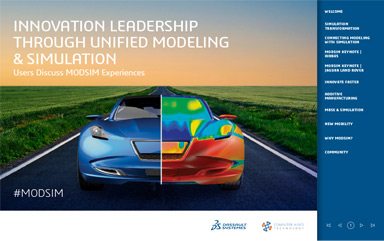Simulating the Way to COVID Safety
MSC Cradle CFD simulation explores the impact of ventilation and social distancing on in-door dining scenarios to promote safe practices aimed at reducing the spread.

The size of particles is indicated by color with the larger (red) particles more likely to settle and the lightest (blue) particles remaining airborne longest. Image Courtesy of Hexagon’s MSC Software
Latest News
February 23, 2021
CFD simulation is emerging as a critical tool to help combat the spread of COVID-19 and to help educate people how to ease back into normal routines, from taking mass transportation to safely sharing a meal with family and friends.
Hexagon’s MSC Software has released an ongoing series of simulations aimed at raising public awareness of the importance of social distancing and wearing protective coverings like masks. In its latest simulation, the company explores the impact of ventilation in social settings, specifically for a group dining together in indoor conditions. The simulation aims to replicate the physical behavior of airborne droplets from those who are speaking in an indoor setting and to explore how social distancing and other practices can mitigate risk of COVID-19 contagion.
Using MSC’s Cradle CFD software, MSC engineers built a simulation tasked with exploring the risks of airborne contagion combined with poor ventilation. The team created a generic dining room with six guests, a heater, top-vented windows, and doors; people were seated next to each other at 0.6m apart with the across-the-table distance about 1.8m apart. As part of the simulation scenario, one person emits droplets and is assumed to be speaking to the adjacent person while all the other participants are sitting, breathing through their noses. The interaction time simulated is 10 minutes.
Cradle CFD’s fast meshing and VoxelFitting meshing approach ensured the simulation could be built without having complete volumes for the fluids and objects, making it easier to replicate the dining environment and scenario compared to doing so with other CFD tools, MSC officials said.
To recreate the scene, the engineers used 3D scanned data of existing rooms or buildings to create the CFD models. The project also took advantage of Hexagon’s ability to scan a cathedral in Japan with a Leica device so it could be modeled with Cradle CFD. MSC’s thermoregulation-model (JOS) human body model, typically used to gauge the comfort level of HVAC or AC controlled environments like offices and car interiors, also played a role in the COVID-spread simulation effort, ensuring the exercise included a realistic approximation of a human body and its behavior. Post-processing work was done to visualize the airflow, temperature, and particles as part of a high-resolution video aimed at democratizing the CFD simulation results for the average person.
The simulation revealed that social distancing is essential regardless of the room’s ventilation patterns. “While ventilation is not failsafe, the unventilated simulation shows that the number of infected particles builds up and travels beyond the recommended distancing minimum of 2m,” the MSC official said. “Getting airflow in the room is very important to maximize the effectiveness of social distancing.”
The simulation revealed a number of interesting patterns. The room with open doors and windows reaches a steady state, showing that ventilation disperses the particles that could be inhaled, up to a peak of around 400 particles. In contrast, the room with no ventilation continues to accumulate particles. The larger particles (showcased in red) begin to settle on the surfaces while the lighter (blue) particles circulate around the room due to heat from the guests and table.
The takeaway is that social distancing, even at a large dining table, is important and that ventilation significantly reduces the concentration of particles. Moreover, the simulation indicates that sitting opposite or not too close on the same side is the preferred mode of seating.
Watch this video to see the Cradle simulation in action.
More Hexagon MSC Software Coverage
Subscribe to our FREE magazine, FREE email newsletters or both!
Latest News
About the Author
Beth Stackpole is a contributing editor to Digital Engineering. Send e-mail about this article to [email protected].
Follow DE




